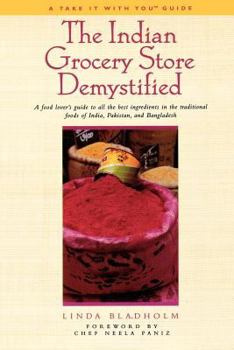The Indian Grocery Store Demystified (Take It with You Guides)
Select Format
Select Condition 
Book Overview
A food lover's guide to all the best ingredients in the traditional foods of India, Pakistan, and Bangladesh. Once upon a time we only had a few choices when it came to fine dining. There was American home-cooked, pretentious French cuisine, practical Italian, and Chinese takeout. These days, Indian restaurants are popping up everywhere, and for good reason. The food is amazing But how can you replicate the Indian dining experience at home? There are thousands of Indian grocery stores to shop in, but what should you buy? How do you prepare it? That's where this Take It With You guide comes in. With 700 entries and over 200 illustrations, plus traditional stories and personal anecdotes about many of the ingredients unique to Indian cuisine, this guidebook identifies and tells you how to use the vast array of spices, rice, legumes, fruits, vegetables, and prepared foods at over 9,000 Indian grocery stores in America. A bonus section of the author's favorite recipes will help you create delicious, authentic dishes that will satisfy anyone's hunger and sense of adventure.
Format:Paperback
Language:English
ISBN:1580631436
ISBN13:9781580631433
Release Date:August 2000
Publisher:St. Martins Press-3PL
Length:272 Pages
Weight:0.05 lbs.
Dimensions:0.8" x 5.9" x 8.9"
Customer Reviews
5 ratings
Dare to buy at the ethnic grocery
Published by Thriftbooks.com User , 17 years ago
As more North Americans become better accustomed to the cuisines of India, the once-obscure ethnic groceries join our shopping destinations. This guide helps you choose from the variety of exotic, aromatic ingredients in the bins and packages of a typical Indian or Pakistani food store. It's especially helpful for produce, or items given only non-English names (what is sooji flour, anyway?)
Fun in Indian Grocery stores
Published by Thriftbooks.com User , 18 years ago
This makes all those interesting packages in an Indian Grocery story understandable and changes the shelves from confusing to fun and usable.
When you're ready to go beyond the cookbook
Published by Thriftbooks.com User , 21 years ago
I've been a slavishly devoted fan of Indian food since 1990, and in the process have managed to become a reasonably accomplished cook. But while there are a host of amazing cookbooks out there that have given me my repetoire, I had not been able to go 'beyond the cookbook' until I got "The Indian Grocery Store Demystified". Beforehand, my visits to the Indian market were very rewarding in that I could identify all the ingredients I needed for my recipes, but I was left with no explanation of what all that other STUFF could be used for. This book helped me to recognize all the wonderful products available, and how they could be used to leap beyond the recipe pages, and actually construct dishes and menus of my very own. Thanks to Linda Bladholm, I am less of a book-taught hobbyist working endlessly to perfect my craft, and more of an intuitive home chef creating satisfying dishes inspired by products that formerly left me puzzled and intimidated. A great resource to anyone who wants to encompass the whole of Indian home cooking, not just a handful of recipes.
Unusual ingredients are explored and shopping tips included
Published by Thriftbooks.com User , 24 years ago
An excellent reference for cooks just venturing into the cuisines of different regions. Indian Grocery Store Demystified provides over 700 entries and 200 illustrations, anecdotes about ingredients and cultural and culinary backgrounds. Unusual ingredients are explored and shopping tips included. Unique in scope and presentation.
A Rosetta Stone for My Vindaloo
Published by Thriftbooks.com User , 24 years ago
Though I've enjoyed Indian cuisine for many years, my first kafkaesque foray into a local Indian grocer ended with my newly acquired rice steamer (thanks again Simon!) gathering dust in its original box for the next three months. But after arming myself with the appropriately titled "Indian Grocery Store Demystified", I feel ready to cross the Rubicon and try my hand at a Machhli Ka Bhujna. Linda Bladholm's guide is an indespensible and comprehensive culinary resource for understanding the wide variety of ingredients requisite to Indian cooking. Each ingredient is described in exacting detail, and Bladholm adds suggestions on their preparation, examples of how each ingredient is typically used in Indian cooking, and her own recommendations for particular brands. The text is peppered throughout with a bit of history and interesting facts about Indian culture. The appendix includes recommended equipment, cooking methods, and a handful of basic recipes. It boasts some nifty sketches to boot (a particularly noteworthy icon is the Gulab Jamun on p. 183, which my untrained eye at first mistook for an Egg McMuffin). Five stars for the inspiration I've been needing to get back into the kitchen with my tamarind paste and garam masala.





